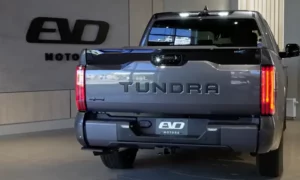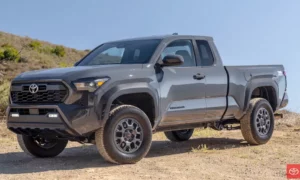Stuck with a Toyota Highlander power liftgate that refuses to budge? You’re dealing with one of the most common frustrations Highlander owners face. Whether it’s completely dead or acting temperamental, a malfunctioning power liftgate transforms a convenient feature into a daily headache. This guide walks you through identifying the problem, fixing it yourself when possible, and knowing exactly when to seek professional help.
Common Causes of Toyota Highlander Power Liftgate Failures
Electrical Issues
The most frequent culprits behind power liftgate failures are electrical problems. Start checking here first.
Blown Fuses
Two key fuses control your Highlander’s power liftgate:
- The 30A “PBD” (Power Back Door) fuse in the engine compartment
- The 15A “DSPLY” fuse under the dashboard
To check these fuses:
- Locate the fuse boxes using your owner’s manual
- Remove suspected fuses with the plastic tweezers provided in the fuse box
- Hold the fuse up to light – if the metal strip inside is broken, replace it immediately
Battery Problems
A weak or dying 12V battery often causes erratic liftgate behavior. The power liftgate system requires consistent voltage to function properly. Many Highlander owners on Reddit report that simply replacing an aging battery solved their liftgate issues.
Mechanical Failures
When electrical components check out fine, mechanical issues are the next likely suspects.
Strut and Hinge Wear
Hydraulic struts naturally lose pressure over time, especially in older Highlanders. Warning signs include:
- Incomplete opening/closing cycles
- Screeching noises during operation
- Sluggish movement, particularly in cold weather
Striker-Latch Misalignment
According to Toyota’s Technical Service Bulletin, many 2008-2013 Highlanders suffer from misalignment between the striker and latch. This occurs when:
- The lateral offset exceeds 31mm between components
- Lift arm studs loosen below the required 10 Nm torque specification
- The liftgate becomes gradually misaligned through regular use
Sensor and Software Glitches
Modern Highlanders use sophisticated electronic systems that can develop their own quirks.
False Obstruction Detection
Your liftgate’s safety sensors might be falsely detecting obstacles:
- The liftgate starts to close
- Suddenly stops and reverses
- Beeps several times to indicate an obstruction
- No actual obstacle exists
Control Module Bugs
Software glitches in the Power Back Door control module can disable operation entirely. These often appear after:
- Battery disconnection
- Electrical system work
- Software updates to other vehicle systems
Model-Specific Troubleshooting Steps
For 2008-2013 Highlanders
These earlier models tend to have more mechanical issues than electrical ones.
Step 1: Check Torque Specifications
If you have access to a torque wrench:
- Locate the lift arm studs
- Verify they’re tightened to 13 Nm
- If below 10 Nm, retorque immediately to prevent further misalignment
Step 2: Perform Manual Override Reset
- Open the glove compartment
- Find and press the power liftgate disable button
- Manually open and close the liftgate five complete times
- Re-enable the power function
- Test operation
Step 3: Inspect Striker Alignment
The striker should align perfectly with the latch mechanism. Even minor misalignment can cause operation problems. Look for:
- Visible gaps when closed
- Uneven panel fitment
- Difficulty during manual closing
For 2014-2019 Highlanders
Mid-generation models introduced more electronic complexity.
Step 1: Reset the System
- Locate the power liftgate button in the dashboard
- Turn the function off
- Wait at least 10 seconds
- Turn the function back on
- Test operation
Step 2: Inspect Touch Sensors
2014-2015 models specifically have issues with faulty touch sensors. Check for:
- Physical damage to sensor areas
- Dirt or contamination on sensors
- Loose wiring connections
Step 3: Check for Cold Weather Impact
Toyota issued a TSB acknowledging that 2014-2015 models experience hydraulic resistance in cold climates. If problems occur mostly in winter:
- Park in a heated garage when possible
- Allow the vehicle to warm up before attempting liftgate operation
- Consider replacing struts with cold-rated alternatives
For 2020-2024 Highlanders
The newest generations have the most sophisticated electronic systems.
Step 1: Perform Sensor Recalibration
- Disconnect the battery negative terminal for 5 minutes
- Reconnect the battery
- Hold the liftgate button until you hear four beeps
- Release and test operation
Step 2: Reset via Infotainment System
- Navigate to Vehicle Settings in your touchscreen
- Select Power Back Door options
- Toggle the system off
- Wait 10 seconds
- Toggle back on
- Test operation
Step 3: Check for Software Updates
Toyota occasionally releases electronic control unit updates that address known issues. Ask your dealer if your vehicle has the latest software version installed.
DIY Repair Options and Costs
Before scheduling an expensive dealer visit, consider these DIY approaches:
Quick and Free Fixes
System Reset Procedure
This simple reset technique resolves many electronic glitches:
- Open your Highlander’s front doors
- Press and hold the power door lock and unlock buttons simultaneously for 5 seconds
- Close the doors
- Test the liftgate
Battery Terminal Cleaning
Corroded battery terminals can cause voltage irregularities:
- Disconnect both terminals (negative first)
- Clean with a wire brush and baking soda solution
- Reconnect (positive first)
- Test liftgate operation
Moderate Cost Repairs
| Repair Option | Cost | Difficulty | Tools Needed |
|---|---|---|---|
| Fuse Replacement | $5-10 | Very Easy | None |
| Strut Replacement | $300-450 (aftermarket) $550-800 (OEM) |
Moderate | Basic hand tools |
| Manual Conversion | $150 | Low | Basic hand tools |
Aftermarket vs. OEM Struts
While aftermarket struts (like StrongArm 4400) cost significantly less, they typically last 3-5 years compared to OEM’s 5-7 years. In harsh winter climates, the OEM’s superior anti-corrosion coating may justify the higher cost.
Legal and Warranty Considerations
Your repair options may be covered by existing programs:
Class Action Settlement
A class action lawsuit against Toyota (Morgan & Morgan v. Toyota) alleged systematic defects in multiple Highlander generations. Owners of 2008-2017 models might qualify for reimbursement if repairs were performed, even at non-dealership shops.
Extended Warranty Coverage
Toyota’s Extended Warranty Program covers liftgate components for up to 10 years or 150,000 miles in regions with high corrosion rates. Contact your dealer with your VIN to verify eligibility.
Preventative Maintenance Tips
Keep your liftgate functioning properly with these simple maintenance steps:
Regular Lubrication
Every 6-12 months:
- Apply dielectric grease to hinge pivots
- Use lithium grease on latch mechanisms
- Wipe away excess to prevent dirt attraction
Battery Maintenance
- Replace your 12V battery every 4 years, even if it seems fine
- Consider a battery tender for vehicles that sit unused for extended periods
- Have your charging system tested annually
Winter Protection
- Park in garages when possible during extreme cold
- For outdoor parking, consider insulating covers for struts
- Operate the liftgate more slowly in sub-freezing temperatures
Understanding Toyota Technical Service Bulletins
Toyota has acknowledged liftgate issues through several Technical Service Bulletins:
TSB For 2008-2013 Models
NHTSA document MC-10131803-9999 identifies specific alignment and torque issues:
- Lift arm studs must maintain 13 Nm torque
- Striker-to-latch alignment is critical
- Repair procedures require precise measurements
TSB For 2014-2015 Models
NHTSA document SB-10084306-5448 focuses on:
- Touch sensor failures
- Cold weather performance issues
- Updated component specifications
Using the Manual Override in Emergencies
When your power liftgate completely fails, you can still access your cargo area:
- Locate the small access panel in the liftgate trim (usually near the latch)
- Remove the panel using a flathead screwdriver
- Insert the screwdriver or your key into the manual release slot
- Turn or push the mechanism to release the latch
- Lift the gate manually
Note that operating the liftgate manually requires more force without the assistance of the power struts.
When System Resets Don’t Work: Advanced Troubleshooting
If basic resets haven’t solved your problem, try these deeper diagnostics:
Testing Motor Function
- Remove the interior liftgate panel
- Locate the motor assembly
- Using a multimeter, check for 12V power at the motor when activated
- No power indicates wiring or control module issues
Checking Position Sensors
- With the liftgate fully open, locate the position sensors
- Check for damage or misalignment
- Clean sensor surfaces with electronic cleaner spray
- Test operation after cleaning
Remember that water intrusion is a common cause of sensor malfunction in older Highlanders. Check weather seals and drain holes for blockages.
Dealing with a malfunctioning Toyota Highlander power liftgate can be frustrating, but methodical troubleshooting often reveals fixable issues. Start with the simplest solutions—checking fuses and performing resets—before moving to more complex repairs. Keep up with regular maintenance to prevent future failures, and don’t hesitate to leverage warranty coverage when available.














